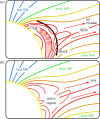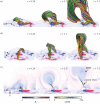Sources of solar energetic particles
- PMID: 31079581
- PMCID: PMC6527952
- DOI: 10.1098/rsta.2018.0095
Sources of solar energetic particles
Abstract
Solar energetic particles are an integral part of the physical processes related with space weather. We present a review for the acceleration mechanisms related to the explosive phenomena (flares and/or coronal mass ejections, CMEs) inside the solar corona. For more than 40 years, the main two-dimensional cartoon representing our understanding of the explosive phenomena inside the solar corona remained almost unchanged. The acceleration mechanisms related to solar flares and CMEs also remained unchanged and were part of the same cartoon. In this review, we revise the standard cartoon and present evidence from recent global magnetohydrodynamic simulations that support the argument that explosive phenomena will lead to the spontaneous formation of current sheets in different parts of the erupting magnetic structure. The evolution of the large-scale current sheets and their fragmentation will lead to strong turbulence and turbulent reconnection during solar flares and turbulent shocks. In other words, the acceleration mechanism in flares and CME-driven shocks may be the same, and their difference will be the overall magnetic topology, the ambient plasma parameters, and the duration of the unstable driver. This article is part of the theme issue 'Solar eruptions and their space weather impact'.
Keywords: coronal mass ejections; flares; shocks; solar energetic particles; solar eruptions.
Conflict of interest statement
The authors declare that they have no competing interests
Figures













References
-
- Reames DV. 1995. Solar energetic particles: a paradigm shift. Rev. Geophys. 33, 585–589. (10.1029/95RG00188) - DOI
-
- Klein KL, Trottet G. 2001. The origin of solar energetic particle events: coronal acceleration versus shock wave acceleration. Space Sci. Rev. 95, 215–225. (10.1023/A:1005236400689) - DOI
-
- Lee MA. 2005. Coupled hydromagnetic wave excitation and ion acceleration at an evolving coronal/interplanetary shock. Astrophys. J. Suppl. 158, 38–67. (10.1086/428753) - DOI
-
- Petrosian V. 2016. Particle acceleration in solar flares and associated CME shocks. Astrophys. J. 830, 28 (10.3847/0004-637X/830/1/28) - DOI
-
- Petrosian V. 2012. Stochastic acceleration by turbulence. Space Sci. Rev. 173, 535–556. (10.1007/s11214-012-9900-6) - DOI
LinkOut - more resources
Full Text Sources
